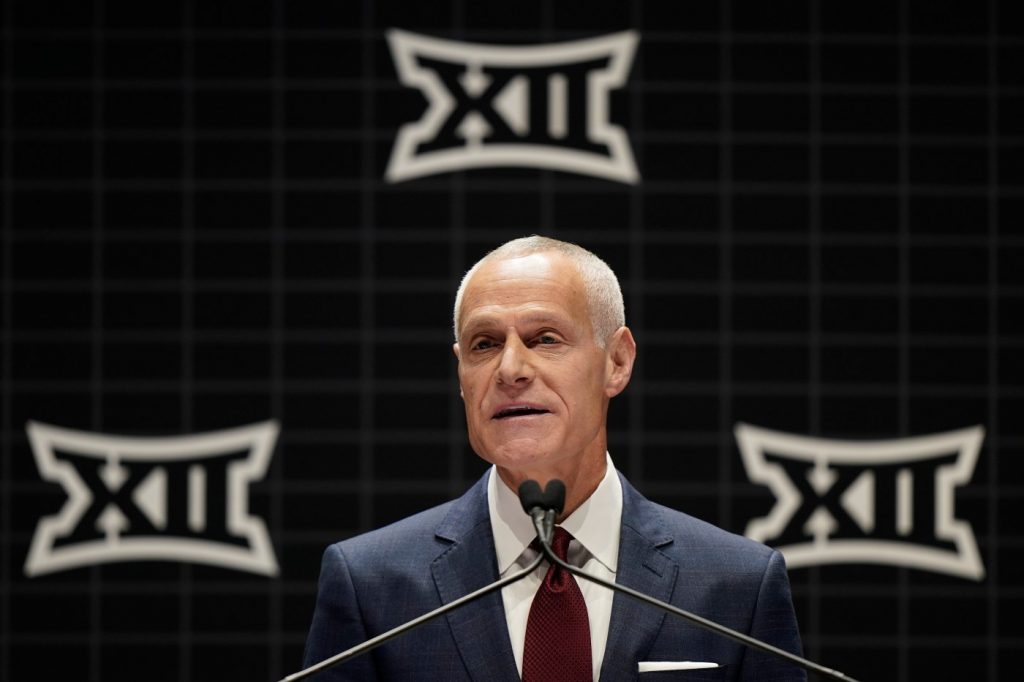Commissioner Brett Yormark emerged from the Big 12’s spring business meetings on the final day of May and, once again, declared his conference “open for business.”
He wasn’t referring to expansion. Instead, Yormark explained in general terms that the Big 12’s membership was committed to exploring “every opportunity to create value.”
Two weeks later, bold strokes are beginning to appear on the canvas.
The conference is considering the sale of its naming rights to a title sponsor, with Yahoo reporting that Allstate, the mammoth insurance company, is a potential partner.
In other words, the Big 12 might become the “Allstate 12.”
The move, unprecedented in major American sports, could generate hundreds of millions of dollars in revenue over the length of the agreement.
Exactly how much changing the Big 12’s name would be worth annually to the 16 universities depends, to a certain extent, on the details.
But Navigate, a sports and entertainment analytics company specializing in sponsorship valuations — its client list includes the SEC and the NFL — estimated that switching to “The Allstate 12 Conference” (or something similar) could generate approximately $3 million per year for each school.
“The fair-market value of naming rights for an entire league is a unique situation,” Navigate president Jeff Nelson told the Hotline on Thursday. “The amount of exposure is so big and, relatively speaking, the benchmarks are so few.
“It’s an immature marketplace. You would really need to spend a great deal of time to track down, measure, and analyze all of the impressions and value to a partner to feel confident in the right fee to charge or to pay.”
The valuation analysis could start with European soccer.
In the early 2000s, Barclays purchased the naming rights to the English Premier League in a deal eventually worth $60 million annually, according to reports.
The deal has long since expired, but a similar naming rights agreement today could approach $100 million per year, Nelson estimated.
Of course, the Premier League is one of the world’s great sports brands. How would the Big 12 compare?
Navigate’s internal discussions on Thursday resulted in a range of informal estimates, from $30 million annually up to $60 million. The midpoint, $45 million, equates to about $3 million per school per year.
“It’s a big number and a big range because of that immature market,” Nelson said. “And it depends on the other inventory included.
“Are there court-side rotational signs or other assets in the venues? Is media (advertising) baked into the football inventory? Is the partner integrated into the championships in other ways? What about hospitality?
“It’s also not like a normal stadium rights or jersey patch.”
One consideration, he added, is market demand.
“When you get into this stratosphere, there are only so many brands that can afford it,” Nelson said. “If one brand says yes at $50 million, great. But if they say no, the next option could be $40 million.”
How might Allstate — or any potential partner — determine the fair value for a marketing partnership that is effectively everywhere at all times?
“If the branding is on every Big 12 football field and basketball court, and if anytime the league is talked about, you have the partner’s name — if ‘Allstate 12’ is everywhere — then the number of impressions is astronomical,” Nelson said.
“But there’s the potential for the law of diminishing returns to impact exposure. Fans would see the Allstate logo for dozens of minutes per game every week. But the 200th minute that fans see the logo is not worth as much as the first minute.
“How do you account for the ubiquitous nature of the partnership? We’ve taken a lot of time to study this with naming rights and jersey patches, but different brands may look at it in different ways.”
Are there any downsides to a multi-year naming rights agreement with no precedent in American sports?
The risk to the Big 12’s reputation is likely limited. The conference is just 30 years old — Yormark calls it a “mature start-up” — and its biggest football brands, Texas and Oklahoma, are joining the SEC this summer.
“They would be giving up some brand equity” by changing to The Allstate 12 conference, “but the risk is fairly low,” Nelson said.
Related Articles
CFB recruiting: Cal lands two-way star as WSU grabs three prospects
Expanded CFP spans three holidays and faces stiff competition from NFL
Julio Frenk named UCLA chancellor: What it means for Bruin athletics
Why the late, great Mike Leach will never be inducted into the College Football Hall of Fame (unless an exception is made)
MBB Top 25: What Dan Hurley’s return means for UConn
“We have found that with stadium naming rights and jersey patches, there has been initial blowback about the sanctity being tarnished, but then the outrage subsides.
“The Big 12 also doesn’t have the same history as the Big Ten or SEC; it hasn’t built up brand equity for nearly as long, so its risk isn’t the same as it would be in those conferences.”
If the details and valuation fall into place, a naming rights agreement seemingly makes sense as Big 12 schools pursue every last dollar to remain competitive with the Big Ten and SEC.
Their predicament lurched toward dire last month with the settlement of a multi-billion-dollar antitrust lawsuit.
According to the negotiated terms in House vs. NCAA, athletic departments in the power conferences will incur an additional $20 million in expenses through a revenue-sharing agreement with the athletes.
The Big Ten and SEC schools have massive media rights deals that provide a cushion. The Big 12 and ACC schools do not.
“The reality post-House, assuming the judge approves the settlement, is that every university, every president and every athletic director has to figure out how to avoid cutting $20 million from their budget,” Nelson said.
“In that respect, a naming rights deal worth $3 million to each school is a godsend.”
*** Send suggestions, comments and tips (confidentiality guaranteed) to [email protected] or call 408-920-5716
*** Follow me on Twitter/X: @WilnerHotline
*** Pac-12 Hotline is not endorsed or sponsored by the Pac-12 Conference, and the views expressed herein do not necessarily reflect the views of the Conference.


